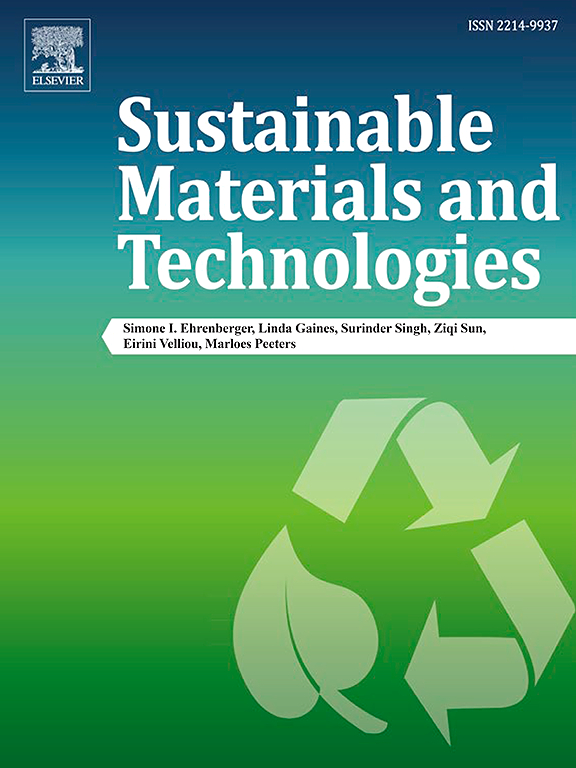生物基聚苯并恶嗪材料的性能及应用研究进展
IF 8.6
2区 工程技术
Q1 ENERGY & FUELS
引用次数: 0
摘要
在全球环保意识日益增强的背景下,传统石化产品因其原料的不可再生性和环境污染问题受到广泛关注。特别是在热固性树脂领域,石油基聚苯并恶嗪(PBz)具有优异的性能,但受限于其原料的不可再生性,给生态环境带来了沉重的负担。近年来,生物基 PBz 应运而生。作为一种前沿技术,它不仅继承了传统石油基同类产品的优异性能,而且在原料来源和绿色可持续发展方面具有显著优势。此外,其分子结构设计的灵活性使其在许多领域都能发挥出色的作用。PBz 作为一种高性能热固性树脂,由于其固有的高交联密度和大体积刚性环结构,在低介电性能方面表现出色。特别是在分子中引入有机磷化合物和呋喃环等含氧杂环结构,可有效提高材料的阻燃性,拓宽其在消防安全领域的应用。PBz 的合成原料主要包括酚类和胺类。其中,酚源可从丰富的自然资源中提取,如香兰素、香草酸、愈创木酚和卡丹醇等;胺源则包括多种选择,如糠胺、硬脂胺、十八胺甚至壳聚糖等。本文重点介绍了近五年来生物基 PBz 在阻燃材料、环氧树脂增强材料和低介电材料方面的研究进展。分析了现有 PBz 材料的不足,并提出了改进方法。展望了生物基 PBz 未来的研究方向。本文章由计算机程序翻译,如有差异,请以英文原文为准。
Research progress on properties and applications of bio-based polybenzoxazine materials
Under the background of increasing awareness of global environmental protection, traditional petrochemical products have received extensive attention due to non-renewable raw materials and environmental pollution. Especially in the field of thermosetting resins, petroleum-based polybenzoxazine (PBz) has excellent properties but is limited by the non-renewable nature of its raw materials, which brings a heavy burden to the ecological environment. In recent years, bio-based PBz has come into being. As a cutting-edge technology, it not only inherits the excellent performance of traditional petroleum-based similar products but also has significant advantages in raw material sources and green sustainability. In addition, the flexibility of its molecular structure design enables it to play an excellent role in many fields. PBz, as a high-performance thermosetting resin, has an excellent performance in low dielectric properties due to its inherent high crosslinking density and large volume rigid ring structure. In particular, the introduction of organophosphorus compounds and oxygen-containing heterocyclic structures such as furan rings in the molecule can effectively improve the flame retardancy of the material and broaden its application in the field of fire safety. The synthetic raw materials of PBz mainly include phenols and amines. Among them, the phenolic source can be derived from abundant natural resources, such as vanillin, vanillic acid, guaiacol and cardanol; the amine source covers a variety of options such as furfurylamine, stearic amine, octadecylamine and even chitosan. This paper focused on the research progress of bio-based PBz in flame retardant materials, epoxy resin reinforced materials and low dielectric materials in the past five years. The shortcomings of the existing PBz materials were analyzed and the improved methods were proposed. The future research direction of bio-based PBz was prospected.
求助全文
通过发布文献求助,成功后即可免费获取论文全文。
去求助
来源期刊

Sustainable Materials and Technologies
Energy-Renewable Energy, Sustainability and the Environment
CiteScore
13.40
自引率
4.20%
发文量
158
审稿时长
45 days
期刊介绍:
Sustainable Materials and Technologies (SM&T), an international, cross-disciplinary, fully open access journal published by Elsevier, focuses on original full-length research articles and reviews. It covers applied or fundamental science of nano-, micro-, meso-, and macro-scale aspects of materials and technologies for sustainable development. SM&T gives special attention to contributions that bridge the knowledge gap between materials and system designs.
 求助内容:
求助内容: 应助结果提醒方式:
应助结果提醒方式:


